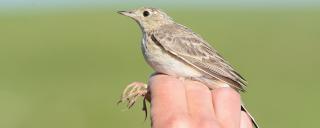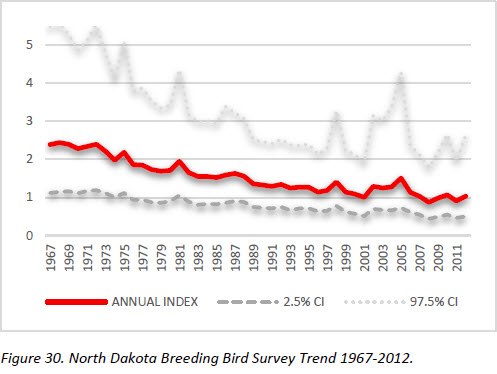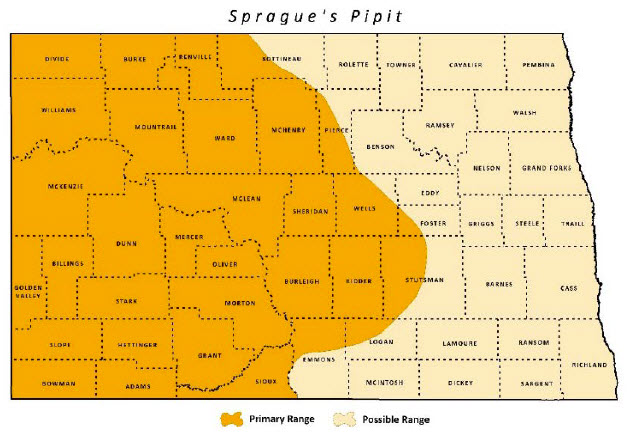
Sprague's Pipit
| Scientific Name | Anthus spragueii |
|---|---|
| General Description | L 6.5”, WS 10”, 0.88 oz. Slender, rather dull light brown, wears a “necklace” of fine streaks. |
| Status | Occurs in North Dakota from mid-April to mid-October. Peak breeding season early May to mid-August. |
| Abundance | Uncommon. |
| Primary Habitat | Extensive tracts of native mixed-grass prairie, ungrazed or lightly grazed prairie. |
| Federal Status | Migratory Bird. Candidate species. |
| Reason for Designation | Declining due to loss and degradation of prairie habitat. Has a restricted breeding range in North America, limited primarily to Montana, North Dakota, and central Canada. It is included on the National USFWS Birds of Conservation Concern list, and also in Region 6, BCR 11 and 17. Partners in Flight (PIF) identifies the Sprague’s Pipit as a Regional Concern and Stewardship Species, U.S.-Canada Concern and Stewardship Species, and a Tri-national Concern Species. |
Locations and Conditions of Key Habitat
Preferred Habitat
Sprague’s Pipits require native grasslands of intermediate height and sparse to intermediate vegetation density, low forb density, and little bare ground but low litter depth. Introduced grasslands may be utilized, but to a much lesser extent. Pipits are most abundant in idle grasslands, but are tolerant of light to moderate grazing. Abundance positively correlated with percent clubmoss cover and dominated by native grass species. Negatively correlated with high percent grass cover, litter depth, low-growing shrubs, and plant communities of Kentucky bluegrass. Avoid areas with woody vegetation and deep litter. The species appears area sensitive, requiring large grasslands of at least 190 ha. Forages primarily on arthropods.
Key Areas and Conditions for Sprague's Pipit in North Dakota
No specific sites have been identified. Highest density of this species occurs in northwestern and north central North Dakota, particularly McHenry County.
Problems Which May Affect this Species
Habitat
Conversion of grassland to cropland, energy development and urban expansion. Degradation of grasslands from invasive plants, woody encroachment, succession, and loss of diversity. Loss of native prairie in North Dakota has greatly affected this species. Overgrazing can cause unfavorable breeding conditions. Encroachment of woody vegetation will also cause negative impacts. Occurrence declines with increasing tall shrub (greater than 1m) cover and by increasing brush (less than 1m) cover.
Other Natural or Manmade Factors
Rates of brood parasitism by brown-headed cowbirds is low. There is no information on the effects of pesticides or other human induced factors. Grassland birds avoid habitat within 150 meters of roads and 350 meters of oilfield infrastructure, likely due to anthropogenic disturbance of heavy traffic and/or changes in habitat near oil development.
Research and Survey Efforts
Current Research or Surveys
- Rocky Mountain Bird Observatory (ND SWG T-XX-R) is estimating demographic rates of Sprague’s Pipit and other grassland birds in western North Dakota. A final report is anticipated in 2018.
Previous Research or Surveys
- University of Montana (ND SWG T-1-R) developed breeding bird models which link population density to local and landscape habitat features in the Prairie Pothole Region of North Dakota. Sprague’s Pipit was one of 16 grassland bird focal species. The project was initiated in 2002, a final report was provided in 2004 (Naugle 2005), and dissertation in 2007 (Quamen 2007). Further analysis of the data was recently analyzed on 5 study species (Doherty et al. in press). Sprague’s Pipit showed avoidance of cropland or selection for grassland at both the landscape and local scales, avoidance for exotic grasses, and showed negative relationship to visual obstruction.
- Fair number of published reports and gray literature on this species throughout its range.
Additional Research or Surveys Needed
Determine the effect of Kentucky bluegrass invasion on Sprague’s Pipit presence/abundance.
Population and Trend Estimates

- PIF Global Population Estimate: 900,000
- PIF North American Population Estimate: 900,000
- PIF North Dakota Population Estimate: 60,000
- North Dakota BBS Trend: see figure 30
- Survey-wide BBS Trend 1966-2012: -3.47
Management Recommendations
- Protect or create large tracts of grassland, particularly native prairie.
- Maintain grasslands free of woody vegetation.
- Burn grassland every 2-4 years.
- Mow hayland using a rotational schedule of every other year.
- Delay mowing until after 15 July.
- Restore cropland to native vegetation.
Monitoring Plans
According to the Partners in Flight Landbird Conservation Plan, long-term population trend monitoring such as the Breeding Bird Survey is generally considered adequate, but may not account for some issues (e.g. bias). Ensuring all BBS routes are conducted annually is priority. Future monitoring proposals should follow recommendations North American Bird Conservation Initiative ‘Opportunities for Improving Avian Monitoring’.
2005-2015 Progress
The Sprague’s Pipit remains a Level I Species of Conservation Priority. Several State Wildlife Grant Projects (T2-11-HM, T-18-R, T-20-D, T-21-D, T-22-HM, T-23-HM, T-25-HM, T-28-L, T-37-D) have contributed to habitat enhancement grasslands for Sprague’s Pipit and other grassland dependent birds.

Note: A listing of works consulted when compiling the information on this page may be found in the 2015 State Wildlife Action Plan.
